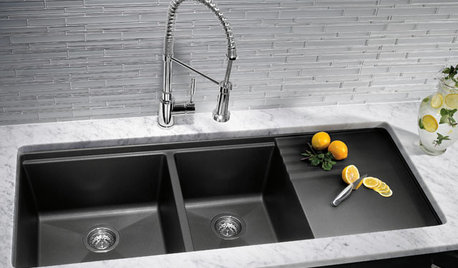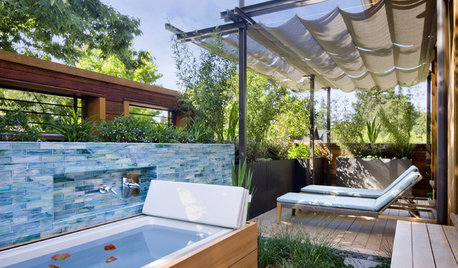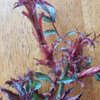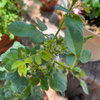hydrogen peroxide for blackspot resistance
Published in: Plant Physiology and Biochemistry, vol 48, page 167-175, (2010)
Authors: Emma W. Gachomo a, Simeon O. Kotchoni b,*
Authors affiliation: a Department of Biology and Microbiology, South Dakota State University, Brookings, SD 57007, USA
b Department of Agronomy, Purdue University, Lilly Hall, 915 West State Street, West Lafayette, IN 47907, USA
From body of full paper: "Reactive oxygen species (ROS) have been reported to control many different processes in plants [25,35]. It has been demonstrated that signalling events leading to the activation of defense systems in various plant species involve ROS [19,22]. We showed here that exogenous application of ROS (H2O2) increased resistance to black spot disease as confirmed by the reduction of yellowing and the inhibition of black spot progression on H2O2-treated leaves (Fig. 7). The use of H2O2 treatment in controlling black spot disease of roses has never been tested before. This work is the first report of using H2O2 in D. rosaee Rosa interaction and suggests that H2O2 treatment alone or probably in combination with fungicide active ingredients can be used/considered as a promising alternative in managing black spot disease of roses. It is thus possible to promote defense response of roses by exposing healthy plants to a moderate concentration of H2O2."
Here is a link that might be useful: link for above
Comments (30)
nastarana
10 years agoI have been wondering. Hydrogen peroxide has some reputation as a kind of folk remedy and preventative for late blight of tomatoes and potatoes, also a fungal infection.
bart_2010
10 years agoWhat is the recommended dosage; i.e., how much hydrogen peroxide per liter/gallon of water? Thanks, bart
Related Professionals
Belmont Landscape Architects & Landscape Designers · Otsego Landscape Architects & Landscape Designers · Wareham Landscape Architects & Landscape Designers · Anderson Landscape Contractors · Lakeland Landscape Contractors · Canton Landscape Contractors · Galt Landscape Contractors · Garland Landscape Contractors · Glendale Heights Landscape Contractors · Hoover Landscape Contractors · Norristown Landscape Contractors · Rockland Landscape Contractors · Stony Brook Landscape Contractors · West Coon Rapids Landscape Contractors · Oxon Hill Landscape Contractorshenry_kuska
Original Author10 years agoRegarding spray concentration, this is the experimental part of the paper. I do not have time now to convert the units now as we have a Doctor's appointment this morning. It sounds like one should spray in the evening.
"Effects of H2O2 treatment on disease development.
Three different concentrations (1, 2 and 3 mM) of H2O2 (Sigma, Steinheim, Germany) were made and sprayed on different rose plants, which were then incubated in the dark for 8 h at room temperature (to avoid the breakdown of H2O2 into H2O in presence of light). Untreated control plants were sprayed with distilled water and incubated under the same conditions. Leaves were collected
from plants treated with the different concentrations of H2O2 (10 leaves per treatment) and placed in 1 mg/ml 3,30-diaminobenzidine (DAB) solution (Sigma, Steinheim, Germany) for the visualization of H2O2 accumulation. DAB was solubilized at pH 5.4 and adjusted to pH 7.5. The chlorophyll was cleared from the leaf samples at 80 C in 80% (v/v) ethanol for 20 h and the leaves imbedded in 10% (v/v) glycerol for observations [44]. DAB is oxidised in presence of H2O2 to give raise to a brownish product, which is easily observed as intense brown zones in the samples [17,32]. In order to study the effects of the H2O2 treatment on the D. rosae infection in rose plants H2O2 treated plants were infected with D. rosae isolates G1 and K1 (3 plants/isolate per concentrations of H2O2). The disease development pattern was observed for 20 d after inoculation. Samples were collected from the infected plants 3, 7, 10 and 20 dpi for protein analysis."henry_kuska
Original Author10 years ago1 mM means having a concentration of one thousandth of a mole per litre. The molecular weight of H2O2 is 34. So a 3 mM solution has 0.102 grams of H2O2 per liter. With the assumption that 1 liter weighs 1000 grams, we have a concentration of 0.01 %. The drugstore hydrogen peroxide is 3% so one would add 1 ml of the commercial hydrogen peroxide to every 99 ml of water to have a 3 mM solution.
------------------------------------------------
For diseased rose seedlings, I recommend one drop of undiluted drugstore hydrogen peroxide.
http://home.roadrunner.com/~kuska/hydrogenperoxide.htm
-------------------------------------------------------------
For general damp off protection of rose seedlings, I recommend 5 ml of 3 % drugstore type hydrogen peroxide to every 95 ml of water.http://home.roadrunner.com/~kuska/Whattodowhenseedsprouts.htm
---------------------------------------------------------------
The paper cited in the rose rosette thread used 20 mM hydrogen peroxide (H2O2) to supress virus in tobacco.""In spite of the enormous information from research on genetics of plant disease resistance, the question still remains unresolved: what is directly inhibiting or killing pathogens and suppressing symptoms in resistant plants? This is particularly true for resistance to viral infections. Here we show that externally applied reactive oxygen species (ROS) such as hydrogen peroxide (H2O2) or ROS-producing (O 2÷â [superoxide] and H2O2) chemical systems infiltrated into tobacco leaves 2 hours after inoculation suppress replication of Tobacco mosaicvirus (TMV) in the susceptible Samsun (nn) cultivar. This was determined by a biological and a real-time PCR method. Infiltration of leaves of the resistant Xanthi (NN) cultivar with the ROS-producing chemicals and H2O2 significantly suppressed local necrotic lesions (i.e. the hypersensitive response) after inoculation of tobacco leaves with TMV. Accordingly, an early accumulation or external application of ROS, such as O 2÷â and H2O2, in tobacco may contribute to the development of resistance to TMV infection."
http://www.akademiai.com/content/q055880253up3p57/
-------------------------------------------------
The rose rosette thread is at:http://forums2.gardenweb.com/forums/load/roses/msg0417381111236.html
Here is a link that might be useful: rose rosette hydrogen peroxide thread
kstrong
10 years agoAlso works on powdery mildew, from what I've been hearing from the exhibitor crowd. The dose they gave me works out to 1 quart per 4 gallon sprayer for the 3% hydrogen peroxide that is cheap and commonly available at the drugstore or the dollar store, which in my mind seems like a pretty strong ratio. They also said it is important to use "food grade" but I think that's bunko. So, I've started out using it at something more like a cup to a cup and a half per four gallon sprayer and I must say -- so far, so good. Seems to work, but then again, I am also using other sprays at the same time. But I think I am noticing a difference even at these lower rates. So I'm slowly working my way up to more, and will stop increasing it when I start to see leaf burn. I did try a full strength -- straight spray of HP with no dilution -- once on a plant I was trying to kill, and it did.
So this is still in the experiment mode for me, but so far, I think I like it.
Kathy in powdery mildew alley. (Coastal SoCal).
henry_kuska
Original Author10 years agoRegarding health concerns of hydrogen peroxide. I do not recommend home use of 35% hydrogen peroxide.
The following epa link may be helpful for dilute use. In particular please note: "Label instructions tell users not to
spray where bees are active."I "think" bees are not active in the late evening. Any comments on this?
Here is a link that might be useful: EPA link
henry_kuska
Original Author10 years agoMSDS (Material Data Safety Sheet) for 2-4% hydrogen peroxide product.
Here is a link that might be useful: link for above
michaelg
10 years agoI think the English units for the 3 mM solution used in the linked experiment experiment would be 2 TB +2 TSP of 3% drugstore peroxide per gallon. Since the 3 mM was more effective than weaker solutions, possibly a yet stronger solution might be more effective.
This is very interesting research. However, the peroxide-treated leaflets (in vitro) were still killed by blackspot--it just took longer. Application to intact plants might be more effective, or not.
henry_kuska
Original Author10 years agoThe following was stated: However, the peroxide-treated leaflets (in vitro) were still killed by blackspot--it just took longer."
H.Kuska comment. I earlier put in quotes the following: "In order to study the effects of the H2O2 treatment on the D. rosae infection in rose plants H2O2 treated plants were infected with D. rosae isolates G1 and K1 (3 plants/isolate per concentrations of H2O2). The disease development pattern was observed for 20 d after inoculation. Samples were collected from the infected plants 3, 7, 10 and 20 dpi for protein analysis."
----------------------------------------------------
H.Kuska comment. Please notice: "from the infected plants" This was not an "in vitro" experiment.Also, I do not understand the comment "were still killed by blackspot--it just took longer".
The authors only treated the plant with H2O2 once. They did not test for what the results would be with a 7, 10, or 14 day spray rotation.This post was edited by henry_kuska on Sat, Jun 8, 13 at 10:33
roseseek
10 years agoHydrogen Peroxide has been the "active ingredient" in Oxygen Plus Fertilizers for many, many years. In that concentration, it helps replace the oxygen in the soil lost due to over watering. I don't know if it's still an ingredient now that Safer has bought the brand, but it was listed on the label for all the years I sold it in retail. Kim
bart_2010
10 years agoOh, dear,I feel like such a dummy,but the scientific language is pretty uncomprehensible to me.Spraying is difficult for me to do, because my garden faces southwest; in the long days of summer, the sun remains high until very, very late,so to avoid leaf burn I have to wait until a very late hour; there's no electricity so I wind up fumbling around in the dark. Not to mention that it's often windy, etc, and I have so many roses that I need to fill up my back-pack sprayer 3-4 times to do them all! I only use copper and sulphur. This year so far I only sprayed once; I've just been too busy. But now I am seeing a lot of b-spot and other dark splotches on leaves of roses that in the past have always been quite healthy (Clair Matin, for example) The weather is probably the main cause; it's been unusually rainy and very humid. So I probably should do another spray...Yet I am also thinking about these comments I see posted ,where people point out that the heavy metals kill ALL fungus, even the good ones that actually help the roses resist disease! So it's very confusing; definitely a difficult question for me. As for growing disese resistant varieties, well, this too has to be taken with a grain of salt, IMHO.My bourbons,in spite of the wet weather are in general quite healthy (keeping fingers, etc crossed, of course),and this category of rose is supposed to be rather sensitive. And I'm certainly not going to SP my beautiful Clair Matin, just because this year it's very spotty.
I guess what I'm asking is: is it safe and worthwhile to use hydrogen peroxide in the spray? What other products are you using, Kathy? Does H. peroxide burn leaves less easily than sulphur? Kim, are you saying that it might be beneficial to put some H.peroxide in the water we use to water our roses? thanks, bartmichaelg
10 years agoBart, when I used copper and sulphur (not in the same tank), I sprayed in the morning. It doesn't matter if the sun comes out as long as temperatures are moderate and the roses are well hydrated. Copper is more likely to burn in the evening when the leaves stay wet with spray for hours. Large smeary blackish blotches on leaves may be copper toxicity.
bart_2010
10 years agoInteresting, michealg! I do have some roses with splotches that don't exactly look like b-spot to me. Yet I did the copper/sulphur spray so long ago I doubt that could be the cause...I was wondering in fact if this was a reaction caused on some of the roses by the sun coming out, shining strongly on leaves that are still we from rain...
How did you do your copper and sulphur sprays? All in the same morning, or did you wait a few days between sprays?roseseek
10 years agoIIRC, the original Oxygen Plus bottles stated they used something like a 1% hydrogen peroxide concentration. Supposedly, that helped provide oxygen to the roots of over watered indoor plants. I guess if your soil is very heavy and you consistently over water, adding a small amount to your watering may help, but I'd think that most of us wouldn't have those conditions. Why add the expense? Kim
seil zone 6b MI
10 years agoInteresting stuff. Being on the lake I'm always looking for things that won't be toxic in the water. Would this be a good alternative or would it still be bad for the lake?
michaelg
10 years agoI used sulfur as my primary fungicide, weekly, for a number of years, maybe ten. I have used copper products (mainly copper soap) off and on, on vegetables or when the roses had unusual problems like spot anthracnose or bacterial blight. I did use copper for a while as the basic rose fungicide. It works, but I would not want to apply it on the scale that I used sulfur. I think a lot of it might be bad for the soil.
mike_rivers
10 years agoFungicides containing hydrogen peroxide and labeled for roses have been around for a long time. One such is Zerotol which is labeled as containing peracetic acid but in water solution peracetic acid is mostly just a mixture of acetic acid and hydrogen peroxide. Zerotol is effective against a variety of plant mildews. I would think if it works against blackspot someone would have noticed it by now.
Here is a link that might be useful: Zerotol
michaelg
10 years agoSeil-- Hydrogen peroxide breaks down very quickly to harmless stuff. As HK suggested at the top, it is best sprayed in the late evening to protect it from sunlight.
henry_kuska
Original Author10 years agomike_rivers, I was aware of Zerotol for professional use (it was/is a 27% concentrate), but not of the home use ready to spray product. Thank you for the link. I tried to find a label and MSDS for the homeowner product but was unsuccessful. The link below is as close as I got:
http://www.biosafesystems.com/PressReleases/NewOxiDateRTS.pdf
Do you know the concentration of H2O2 in this product? It is possible that the concentration was decided on to give maximun contact kill instead of maximum immune response inducer. Also, I do not know the effect of the acetic acid on the immune response. My first "guess" would be that a Salicylic acid and hydrogen peroxide mixture would be better for immune response enhancing.
Here is a link that might be useful: undated press release
henry_kuska
Original Author10 years agoAs an example that immune enhancers are still something new, I present a 2013 scientific paper concerning control of a leaf fungus on olive trees with salicylic acid.
"Olive leaf spot caused by Spilocaea oleagina is mainly controlled by copper fungicides but there is a growing need for alternative control strategies, such as induced resistance. This study investigated the potential for control of the disease with products reported to induce systemic acquired resistance. The eight products: salicylic acid (SA), 5âÂÂchlorosalicylic acid, chitosan, brotomax, 3-amino butyric acid, Foli-R-Fos 400, acibenzolar-S-methyl, potassium silicate and copper sulphate fungicide were used as foliar spray applications, and potassium silicate also as a soil drench. All compounds except brotomax, 5-chlorosalicylic acid and potassium silicate (foliar spray) reduced disease severity, by 48��"89 %, with salicylic acid being most effective. SA reduced disease severity by 89 and 87 % when applied 2 or 4 weeks prior to inoculation, respectively, which was similar to the standard copper sulphate spray. In general, the inducers were more effective in reducing disease severity when plants were treated twice than when treated once prior to inoculation. The level of disease reduction was similar for all treatments (68��"86 %) when applied 4âÂÂ+âÂÂ2 weeks prior to pathogen inoculation, except for brotomax (52 %). This investigation has identified products that may be used in organic or integrated management programmes for control of olive leaf spot, thereby reducing potential harmful effects such as fungicide resistance and accumulation of copper in orchard soils."
Here is a link that might be useful: link for above
henry_kuska
Original Author10 years agoThis is a 2009 USDA scienific paper that concludes that for their plant (daylily) and disease (rust)"
"Disease incidence and severity decreased with increasing concentration and number of applications of H2O2 per week. H2O2, at 108 g a.i. l1 applied once per week, provided control equal to a fungicide treatment (azoxystrobin and chlorothalonil plus thiophanate-methyl rotation), but was also significantly phytotoxic. In a greenhouse study, two concentrations (2.0 and 2.7 g a.i. H2O2 l1) registered for application on plants and one concentration (3.4 g a.i. H2O2 l1) registered for application on production surfaces were sprayed 2, 3, and 5 times per week on healthy daylily plants exposed to naturally dispersed inoculum. In greenhouse experiment I where the maximum mean incidence was 59%, 2.7 and 3.4 g a.i. H2O2 l1 applied 2��"5 times per week provided control equal to the fungicide treatment. In greenhouse experiment II where the maximum mean incidence was 89%, 5 applications of H2O2 at 2.0��"3.4 g a.i. H2O2 l1 provided control that was better than the water treatment but not as good as the fungicide treatment. Higher label concentrations (2.7 g a.i. H2O2 l1) and multiple applications per week (5) can provide disease control equal to a fungicide when disease pressure is low, but may not be effective when disease pressure is high."
Here is a link that might be useful: link for paper
michaelg
10 years agoAspirin (acetyl-salicylic acid) has been tried anecdotally as an immune booster to reduce blackspot in rose. I am not aware of any scientific trial. Aspirin is phytotoxic, but IIRC one-half or two-thirds of a standard 325 mg tablet (per gallon of water) was used without noticeable burning.
greentiger87
10 years agoThere seem to be a lot of chemists on this thread, so hopefully one of you can check my thinking here:
Peracetic acid is created in large amounts by mixing concentrated H202 with concentrated acetic acid. But in the final dilution, there should be an equilibrium between the three compounds (H202, acetic acid, peracetic acid), in which peracetic acid is only present in small concentrations. However, peracetic acid reacts very rapidly, and the equilibrium provides a constant source of it as it is used up, making it effective even though it's only barely present.
If this is case, shouldn't dilute vinegar and dilute hydrogen peroxide provide an almost identical product, if used immediately? The addition of a compatible surfactant, which seems to include common spreader-stickers and SLS, would bring it even closer.
As far as I'm aware, acetic acid doesn't have any significant signaling effects on plants. Conveniently, salicylic acid is compatible with hydrogen peroxide - it's used as an aromatic stabilizer in cleaning formulas.
I've long used hydrogen peroxide as a foliar "disinfectant" for ectoparasitic fungi and some bacterial diseases. It works - the main downside is the frequency of application, which is reflected in some of the studies linked above. Even full strength drugstore peroxide, 3%, doesn't seem to harm most plants as long as a small amount of spreader-sticker or surfactant is included to keep the drops from collecting/concentrated in small areas. It's pretty much equivalent to dilute bleach in this application, but without the hazards of applying sodium and chloride ions to leaves.
I can't see the full paper linked in the original post - for those who have read it, how big was the difference between the treated and control? Often flat effectiveness is reported even when the actual effect size is very small.
henry_kuska
Original Author10 years agogreentiger87, my interpretation of the full paper is that quantitative data were obtained. But the data are not presented. Mention is made of a web version ("(For interpretation of the references to colour in this figure legend, the reader is referred to the web version of this article.)"
I did not find a second version.
henry_kuska
Original Author10 years agogreentiger87 I can send you a copy of the paper if you e-mail me your e-mail address that accepts PDF attachments.
henry_kuska
Original Author8 years agomargie
8 years agoThanks Henry. I have been using Oxidate by Biosafe for years in my garden (roses etc.). It's a bactericide and fungicide - kills right away. The best way I can describe it: super strong hydrogen peroxide. I live on Long Island (zone 6b) and black spot is/can be a big problem here.If you get a chance check it out. Margie


















amberroses